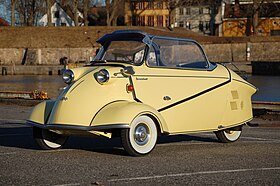Messerschmitt Kabinenroller
| Messerschmitt Kabinenroller | |
|---|---|

|
|
| Overview | |
| Manufacturer |
Messerschmitt (1953-1956) Fahrzeug- und Maschinenbau GmbH, Regensburg (1956-1964) |
| Also called | Karo, Mivalino (Italian-built KR175s) |
| Production | 1953-1964 |
| Assembly | Germany: Regensburg (Regensburger Stahl- u. Maschinenbau (1953-1956), Fahrzeug- und Maschinenbau GmbH, Regensburg (1956-1964)) Italy: Brescia (Metalmeccanica Italiana Valtrompio s.p.a.) (1954-1956) |
| Body and chassis | |
| Class | microcar |
| Layout | RMR |
| Body style(s) | Tandem 2-seat three-wheeler (except Tg500 with four wheels) with side-opening canopy: saloon, cabriolet, or open roadster, depending on canopy style. |
| Vehicles |
|
| Powertrain | |
| Engine(s) | KR: Fichtel & Sachs two-stroke single cylinder
|
| Transmission(s) | KR: Four forward speeds, sequential, unsynchronized Tg500: 4 speed H-pattern plus reverse |
| Dimensions | |
| Wheelbase | KR: 2,029.5 mm (79.9 in) Tg500: 1,884.7 mm (74.2 in) |
| Length | KR: 2,819.4 mm (111 in) Tg500: 2,997.2 mm (118 in) |
| Width | KR: 1,219.2–1,237.0 mm (48.0–48.7 in) Tg500: 1,270.0 mm (50.0 in) |
| Height | KR: 1,198.9 mm (47.2 in) Tg500: 1,244.6 mm (49.0 in) |
| Curb weight | 218–389 kg (480–858 lb) |
The Messerschmitt Kabinenroller (Messerschmitt Cabin Scooter) was a series of microcars made by Messerschmitt from 1953 to 1956 and by Fahrzeug- und Maschinenbau GmbH, Regensburg (FMR) from 1956 to 1964. All the Messerschmitt and FMR production cars used the Kabinenroller's monocoque structure, featuring tandem seating and usually a bubble canopy.
The Kabinenroller platform was used for four microcars, the three-wheeled Messerschmitt KR175 (1953-1955), Messerschmitt KR200 (1955-1964) and Messerschmitt KR201, and the four-wheeled FMR Tg500 (1957-1961). The platform and all four cars using it were designed by Fritz Fend.
The Kabinenroller was designed and developed by Fritz Fend for Messerschmitt AG. Fend had earlier designed and built a series of unpowered and powered invalid carriages, leading up to his Fend Flitzer. Fend noticed that able-bodied people were buying Flitzers for use as personal transport. This led him to believe that a mass-produced two-seat version of the Flitzer would have a ready market. A search for a manufacturer interested in the project led him to Messerschmitt, who had him develop the project for production in their Regensburg factory.
The Kabinenroller was designed and developed for production in 1952 and 1953. Production of the original version, the KR175, began in February 1953. 70 modifications had been made to the design by June 1953.
The KR200 was developed on the Kabinenroller platform and replaced the KR175 in 1955. Based on the same frame and an evolution of the original suspension, the KR200 had a large number of detail changes. On 29–30 August 1955, a modified KR200 with a tuned engine, revised gear ratios, redundant control cables, a one-off streamlined body, and stock suspension, damping, steering, and brakes, was run at the Hockenheimring for twenty-four hours. During the run, the vehicle set twenty-two closed-circuit speed records for three-wheeled vehicles with displacements up to 250 cc, including the fifty-mile record at 107 km/h (66.5 mph) and the twenty-four-hour record at 103 km/h (64.0 mph).
...
Wikipedia
